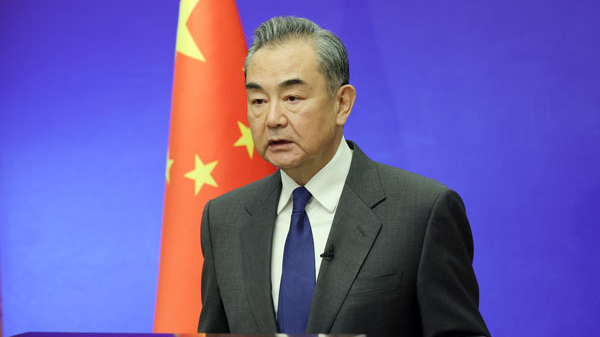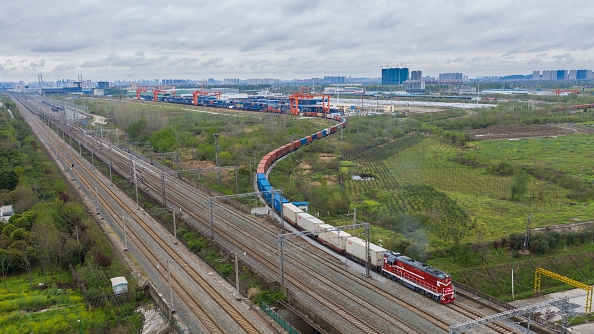
Chinese State Councilor and Foreign Minister Wang Yi addresses the 17th China and Central and Eastern European Countries (CEEC) National Coordinators' Meetings via videolink, December 16, 2022. /Chinese Foreign Ministry
Chinese State Councilor and Foreign Minister Wang Yi addresses the 17th China and Central and Eastern European Countries (CEEC) National Coordinators' Meetings via videolink, December 16, 2022. /Chinese Foreign Ministry
Editor's note: Hannan Hussain is a foreign affairs commentator and author. He is a Fulbright recipient at the University of Maryland and a former assistant researcher at the Islamabad Policy Research Institute. The article reflects the author's opinions and not necessarily the views of CGTN.
On December 16, Chinese State Councilor and Foreign Minister Wang Yi addressed the 17th China and Central and Eastern European Countries (CEEC) National Coordinators' Meetings via a video link. No matter how the international landscape may change, the two sides should follow through on the consensus reached at the China-CEEC Summit 2021 and make the bilateral cooperation more resilient, coordinated, open and beneficial to all, said Wang.
His fourfold proposal for deepening cross-regional cooperation highlights efforts to expand trade, competitive business engagements, and institutional building of the past. A more balanced development in Europe demands that China and CEE countries operate in sync to deliver tangible connectivity benefits for all.
China's intent to deliver more growth points for agricultural products, e-commerce, finance and interconnectivity are an investment in measures agreed upon in the past. For instance, on connectivity alone, there has been a steady increase in developed transport connections across several CEE countries. Similarly, China's trade with CEE partners has also expanded, benefitting in part from the strong leadership consensus on multisector CEE cooperation, as witnessed in the aftermath of the 2021 China-CEEC Summit.
China and its CEE partners will contribute to the overall development of Europe. Beijing's pragmatism over economic and trade resilience with their relationship remains "integral" to broader China-EU cooperation.
Wang's four-fold cooperation proposal also emphasized stronger synergy with all countries involved. Diversification of development interests is necessary, given its positive role in elevating Chinese foreign direct investment there to a gross total of $3.14 billion by the end of 2020. There's also effort underway to scale China-EU economic cooperation across complimentary digital, technology, trade and finance spheres, endorsing stronger diplomatic support for China-CEEC expansion. Wang's address goes further by underlining the value of market rules and EU standards, given that two-way cooperation stands in line with those expectations. It's the chief interest of both sides to facilitate cross-regional cooperation as a major consideration for the 2021 China-CEEC Summit consensus.

China-Europe freight train starts from Wuhan Central Station of China Railway Union, Wuhan City, Hubei Province, China, March 28, 2020. /Getty
China-Europe freight train starts from Wuhan Central Station of China Railway Union, Wuhan City, Hubei Province, China, March 28, 2020. /Getty
Expect solidarity and friendship to play the role of a mainstay going forward. The latter has served as a key feature of Beijing's overall policy towards Europe, and should be seen as a lever to forge stronger people-to-people linkages. New understandings between China-CEE communities can promote "win-win results" where cross-regional development benefits are tailored to the interests of the people.
CEE countries have used the mechanism to gain deeper market penetration for products in China. There's greater product visibility through key platforms, such as the China International Import Expo. Wang's admission that China will import more competitive products from CEE countries promises to build on that momentum, along with Beijing's treatment of CEE companies as market equals.
China-CEEC cooperation has a common stake in opening up to the world. We have observed a significant increase in foreign direct investment (FDI) inflows for CEE countries over the years. Additionally, China remains committed to opening up further to the world. Add to both the potential to expand their two-way FDI, while future cooperation can prove resilient by responding to investor sentiment.
As recently as 2019, one of the hallmarks of the China-CEEC cooperation mechanism was its alignment with key characteristics – from openness, inclusiveness to mutual benefit and win-win results. There's no reason why their development cooperation shouldn't strengthen to meet a "common desire for rejuvenation."
All told, Wang's fourfold proposal to deepen China-CEEC cooperation draws strength from their complimentary developmental advantages. This relationship has withstood the test of time, and prevailed over intricate changes in the international landscape to become a source for common prosperity.
(If you want to contribute and have specific expertise, please contact us at opinions@cgtn.com. Follow @thouse_opinions on Twitter to discover the latest commentaries on CGTN Opinion Section.)